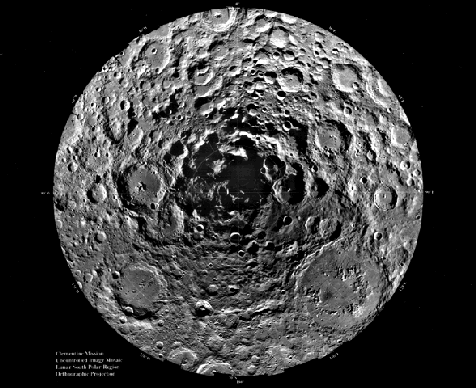Explanation: Ice on the Moon? The prospecting Clementine spacecraft may well have discovered it. In 1994, Clementine spent 70 days in lunar orbit mapping the Moon's surface. Shown above is a dramatically detailed composite view centered on the Lunar South Pole - constructed from 1500 Clementine images. This area contains part of the South Pole-Aitken impact basin, the largest known crater in the solar system, probably caused by the impact of a comet or asteroid. The depth of the basin and crater walls at the Lunar South Pole create the permanent shadow region visible above - hypothesised to be large and cold enough to trap water brought to the moon by cometary impacts as surface ice. Indeed, a recent analysis of Clementine data from this area has found a signature of water ice. Water on the Moon presents exciting possibilities as resource for future lunar exploration.
1999 2000 2001 2002 2003 2004 2005 2006 2007 2008 2009 2010 2011 2012 2013 2014 2015 2016 2017 2018 2019 2020 2021 2022 2023 2024 2025 |
Yanvar' Fevral' Mart Aprel' Mai Iyun' Iyul' Avgust Sentyabr' Oktyabr' Noyabr' Dekabr' |
NASA Web Site Statements, Warnings, and Disclaimers
NASA Official: Jay Norris. Specific rights apply.
A service of: LHEA at NASA / GSFC
& Michigan Tech. U.
|
Publikacii s klyuchevymi slovami:
ice - south pole - Yuzhnyi polyus - Luna - led
Publikacii so slovami: ice - south pole - Yuzhnyi polyus - Luna - led | |
Sm. takzhe:
Vse publikacii na tu zhe temu >> | |
